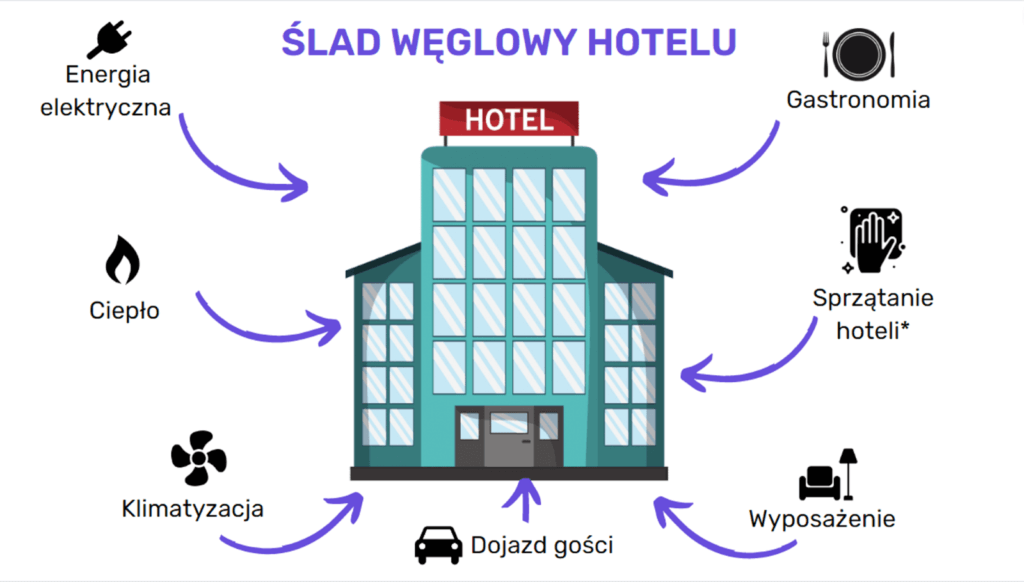How to calculate the carbon footprint in the hotel industry


There is a growing awareness in the hotel industry about CSR activities and carbon footprint calculations. Hotels are recognizing the need to reduce their environmental impact. They also see the importance of meeting the growing consumer demand for sustainable and eco-friendly travel options. Meeting sustainability goals will result in long-term positive changes, which will translate into benefits for the property, the hotel industry, and climate change.
Hotels contribute about 1 percent of global carbon dioxide emissions. Of the 36.3 billion tons of carbon dioxide emitted worldwide in 2021, hotels generated about 363 million tons – roughly enough to power about 45.7 million homes per year. This article let you know what counting the hotel industry’s carbon footprint looks like and its benefits.
The sum of total greenhouse gas emissions generated by an organization, product, or person is the carbon footprint. It includes emissions of carbon dioxide, methane, nitrous oxide, and other greenhouse gases expressed in CO2 equivalent (CO2e). A carbon footprint is one method of calculating the impact of a particular company or thing, or even a person himself, on the climate.
Carbon footprint monitoring typically involves measuring the number of greenhouse gases generated by a hotel’s activities, such as energy consumption, waste management, and transportation. This data can be used to identify areas where the hotel can reduce emissions.
Before answering this question, we encourage you to look at the illustration below. It shows all the main factors which had to be considered when calculating a hotel’s carbon footprint:

Based on the indicators developed in accordance with the GHG Protocol and the ISO 14064-1 standard, it can be pointed out that the biggest impact on the CO2 value of a hotel is the amount of electricity used, the diet, the guest’s mode of travel and the equipment of the hotel room. Interesting fact: according to UK Government GHG Conversion Factors for Company Reporting, one room-night in a hotel in Poland is 33.3 kg CO2e.
Below you will find information on how to reduce your hotel’s carbon footprint in a few steps:

Although the mentioned measures are achievable for many facilities, we still find industry representatives who either do nothing or take frivolous actions that are mere greenwashing – and this, especially in the face of the CSRD directive introduced by the European Union, is an image and business shot in the knee.
It’s not just about planting a certain number of trees, changing to wooden mixers, or sticking a sticker that says “save water and light” or a rainwater harvesting initiative. The example should come from the top, and actions should be transparent for everyone – downstream employees and visitors. Similarly, purchasing carbon credits without first trying to reduce them will not take care of zero carbon emissions. You can’t take the easy way out in reducing the carbon footprint.
Responsibility for people, and employees, is also one of the cornerstones of sustainable hotel CSR. It is significant to educate them about the carbon footprint and environmental protection; explain how they can contribute to reducing the hotel’s emissions with their daily actions. In the daily whirlwind of work, there is no time to think about which responsibilities have what amount of carbon footprint.
It is worth taking advantage of the simple, yet regulatory-compliant tools available for calculating and preparing reduction strategies. This intuitive software will guide the facility manager through the calculating process, even with no specialized knowledge.
The advantage of this type of tool is the storage of data in one place, a renewable form of payment (usually access is granted for 12 months), and the ability to generate a report that can be presented to investors or counterparties.
Calculating carbon and water footprint of the hotels is a significant step in creating a more sustainable and environmentally friendly hotel industry. Why is counting a hotel’s carbon footprint important and worth doing?
First, the hotel industry has a significant impact on the environment, including through the consumption of energy, water, and raw materials, as well as the generation of waste. By calculating a hotel’s carbon and water footprint, we can better understand the hotel industry’s impact on the environment and identify areas where improvements can be made.
Second, customers are increasingly interested in the environmental impact of the services they choose, including hotels. By providing information on the value of a hotel’s carbon and water footprint, customers can make more informed decisions about their hotel choices and prefer those with more sustainable operations. According to Booking.com, 70% of travelers prefer to choose a property that uses sustainable hospitality practices.
Third, by calculating a hotel’s carbon and water footprint, we can hold the hotel industry accountable for its environmental impact. It can help drive change in the industry and encourage hotels to adopt more sustainable practices.
Fourth, governments and other organizations can use hotel carbon and water footprint data to develop policies and regulations to reduce the hotel industry’s environmental impact.

Sooner or later, every property will face the obligation to count and report its carbon footprint, the sooner it starts, the more it can gain, and the reduction of greenhouse gas emissions will be more effective.
Net-zero hotels are increasingly recognized, so having a good reputation can attract more guests, which will translate into profit from increased sales. In addition, it is also a way to retain the most talented employees, and as research shows, they want to work for sustainable companies. The potential that lies in the pursuit of sustainability can make it possible to expand cooperation with other industries, and the achievements are sure to be appreciated by investors.
The article was written as part of a directory of best practices – CSR in the hotel industry.
The Carbon Border Adjustment Mechanism (CBAM) was introduced in response […]
Table of content Introduction The introduction of double materiality in […]
Table of content Energy efficiency in business is becoming an […]